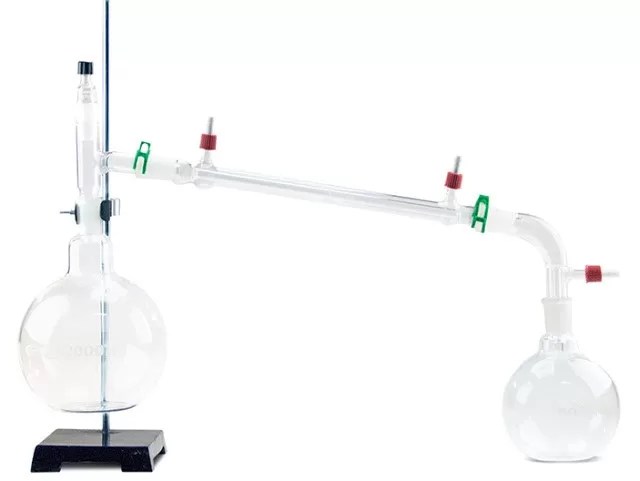Ethanol extraction is one of our favorite methods, especially when run size gets beyond practical size limits for LPG extraction, and high monoterpene retention isn’t a goal. FDA considers Ethanol GRAS, or Generally Regarded As Safe, and in fact it is so safe that you can buy in by the jug at your local liquor store.
Alas, there lies the chagrin, because it can be drunk and is known to be evil, there is a sin tax attached, and is actually how the US government was run before Income Taxes.
Now we have income taxes as well as “Whiskey Taxes”, which makes the alcohol that much more precious to us by the time we’ve slaved for the money, paid income taxes on it, and with what was left paid heavy taxes on the alcohol.
Leading naturally to the question of whether you can reclaim and recycle it over and over?
Leading to the elusive answer that its easier done than blessed, because there are also rules about where a still can be run, and about licensing and permitting to both protect public health and safety, as well as insure the revenuers get their taxes.
There is some relaxation in the law with regard to stills used to extract essential oils, as well as stills under a gallon used in laboratories, but check local law enforcement’s interpretation before proceeding at your own risk.
It’s easy to find distillation glassware by just Googling that or checking Amazon, and Ebay. Mostly made over the pond so as to keep over all costs down, with quality caveat emptor.
You can also purchase it from folks who sell lab equipment like:
http://www.labdepotinc.com/c-534-distillation-kits.php

Simple laboratory still
The Australians also offer this keen Mega Home counter top alcohol still:

Megahome still
You can build one. Here is a DIY that I put together from an All Clad asparagus steamer that I just happened to have around surplus, along with a stainless salad bowl and some copper tubing.
Parts list as follows:
1.0 (1) All Clad stainless asparagus steamer
2.0 (1) 10″ Stainless steel mixing bowl
3.0 (2) 1/8″ NPT brass bulkhead fitting
4.0 (1) Neoprene O rings for lid 5.375″ X .125″
5.0 (2) Neoprene O ring for bulkhead fittings 5/8” X .125
6.0 (1) 1/8” MNPT elbow to 3/16” compression
7.0 (1) 1/8″ MNPT to 3/16″ compression
8.0 (1) 5 gallon plastic bucket
9.0 (2) 1/4″ 20 X 4″ Plated carriage bolts
10.0 (2) 1/4″ Plated washer
11.0 (2) 1/4″ Stainless or chrome wingnut
12.0 (1) 3/4″ X 8 1/2″ X 2″ Oak block
13.0 (4′) 3/16″ ID Neoprene fuel hose
14.0 (2) 3/8″ Hose screw clamps
15.0 (12.5′) 3/16″ ID copper refrigeration tubing
I drilled holes in the handles to allow me to secure the lid with an oak beam and an o-ring. I put a fitting through the lid and through the bottom of the salad bowl using 1/4″ bulkhead fittings with an o-ring.

Lid components and mods

Components
For heat, I used a Cussinard Fondue Pot full of canola oil at 250F:

Assembly in hot oil bath
I used neoprene fuel hose for alcohol resistance to connect the still to the condenser. The condenser consists of a coil of 1/4″ copper tubing sitting in the stainless salad bowl full of ice water. It sits on a stand made from a cat litter bucket and feeds the recovered alcohol through the bulkhead fitting in the bottom of the bowl into an empty 1.75 liter jug.

Condenser Components

Condenser assembly
Which sits on this modified scientific quality cat litter bucket:

Modified scientific grade cat litter bucket
And goes together like this:

Which operates like this: Note the neoprene fuel hose and towel wrap to increase thermal efficiency:

Complete still in action
Here it is again with a chilled head using a small stainless bowl full of icewater:

Alternate refluxing with chilled head.
And speaking of refluxing stills, D Gold offers the ISO 3 Quartermaster and the ISO 4 Kilomaster reflux stills, that can be used both soxhlet extraction as well as subsequent recovery. Check the articles under those titles for details on their operation.
The basic difference between a simple pot still, and a reflux still, is that the pot still has an external condenser and the reflux still condenses against a chilled head and rainfalls back into the internal collection vessel.

Iso-3 Quartermaster
Extract Craft also produces a vacuum assisted soxhlet extractor and reflux still, which allows recovery of the alcohol at lower temperatures. See the article by that name for more details on its operation.

Extract Craft Source Turbo without chilled head

Adding chilled head
Moving up in budget, Eden Labs offers there Ethanol recovery and fractional distillation unit. It heats with a mantle and uses magnetic stirring to create a thin film to accelerate the alcohols evaporation.

Stirring mantle with boiling vessel, condenser, and recovery flask
